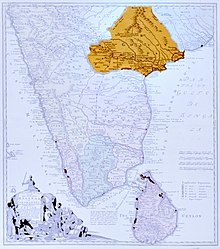
Back ಗೋಲ್ಕೊಂಡ ವಜ್ರಗಳು Kannada கோல்கொண்டா வைரம் Tamil గోల్కొండ వజ్రాలు Tegulu Kim cương Golconda Vietnamese
 A 1733 map of Golconda Sultanate—the term Golconda diamond became synonymous to the diamonds of good quality.[1] | |
| Color | Typically colorless; less often blue, translucent white, and pink. |
|---|---|
| Cut | Antique cushion |
| Country of origin | India |
| Mine of origin | Kollur mine, Paritala and mines of Godavari delta |
Golconda diamonds are mined in the Godavari-Krishna delta region of Andhra Pradesh, India. Golconda Fort in the western part of modern-day Hyderabad was a seat of the Golconda Sultanate and became an important centre for diamond enhancement, lapidary, and trading. Golconda diamonds are graded as Type IIa, are formed of pure carbon, are devoid of nitrogen, and are large with high clarity. They are often described as diamonds of the first water, making them among history's most-celebrated diamonds. The phrase "Golconda diamond" became synonymous with diamonds of incomparable quality.
For 2,000 years, Golconda diamonds were the only-known fine diamonds. Due to centuries of excessive mining, their production was exhausted by 1830, and gemologists and traders have classified Golconda diamonds as antique, rare and precious. Famous Golconda diamonds include the colourless Koh-i-Noor, the Nassak Diamond, the blue Hope Diamond, the Idol's Eye, the pink Daria-i-Noor, the white Regent Diamond, the Dresden Green Diamond, and the colourless Orlov Diamond, as well as now-untraceable diamonds such as the yellow Florentine Diamond, the Akbar Shah, the Nizam Diamond, and the Great Mogul Diamond.
The Golconda diamond industry was at its peak in the 16th-to-18th centuries when 23 mines, of which Kollur Mine was the most active, operated in the region and 30,000 people at a time worked in one mine.[A] The output from all of the mines in Golconda is estimated to be around 10,000,000 carats (2.0 t). In 2015, Osmania University in collaboration with Geological Survey of India discovered potential new sites for diamond mining in the region, though as of 2022[update] mining had not started.
Several literary legends were inspired by Golconda diamonds; these include Sindbad the Sailor's valley of diamonds, the gem lore of Marco Polo, and the theme of Russell Conwell's inspirational lecture "Acres of Diamonds". According to folklore, some Golconda diamonds are cursed; these impart good luck to their owners or have mystical powers while others were worn as talismans. In 2013, the Princie Diamond from the Jewels of the Nizams was auctioned for US$39.3 million—the highest-recorded auction price for Golconda Diamonds and the world record for US$1.1 million per carat. In a heist in 2019, the Dresden White Diamond was stolen along with jewels worth US$1.2 billion.
- ^ For a map of their territory see: Schwartzberg, Joseph E. (1978). A Historical atlas of South Asia. University of Chicago Press. p. 147 map XIV.4 (l). ISBN 978-0-19-506869-6. Retrieved 15 August 2022.
Cite error: There are <ref group=upper-alpha> tags or {{efn-ua}} templates on this page, but the references will not show without a {{reflist|group=upper-alpha}} template or {{notelist-ua}} template (see the help page).
© MMXXIII Rich X Search. We shall prevail. All rights reserved. Rich X Search